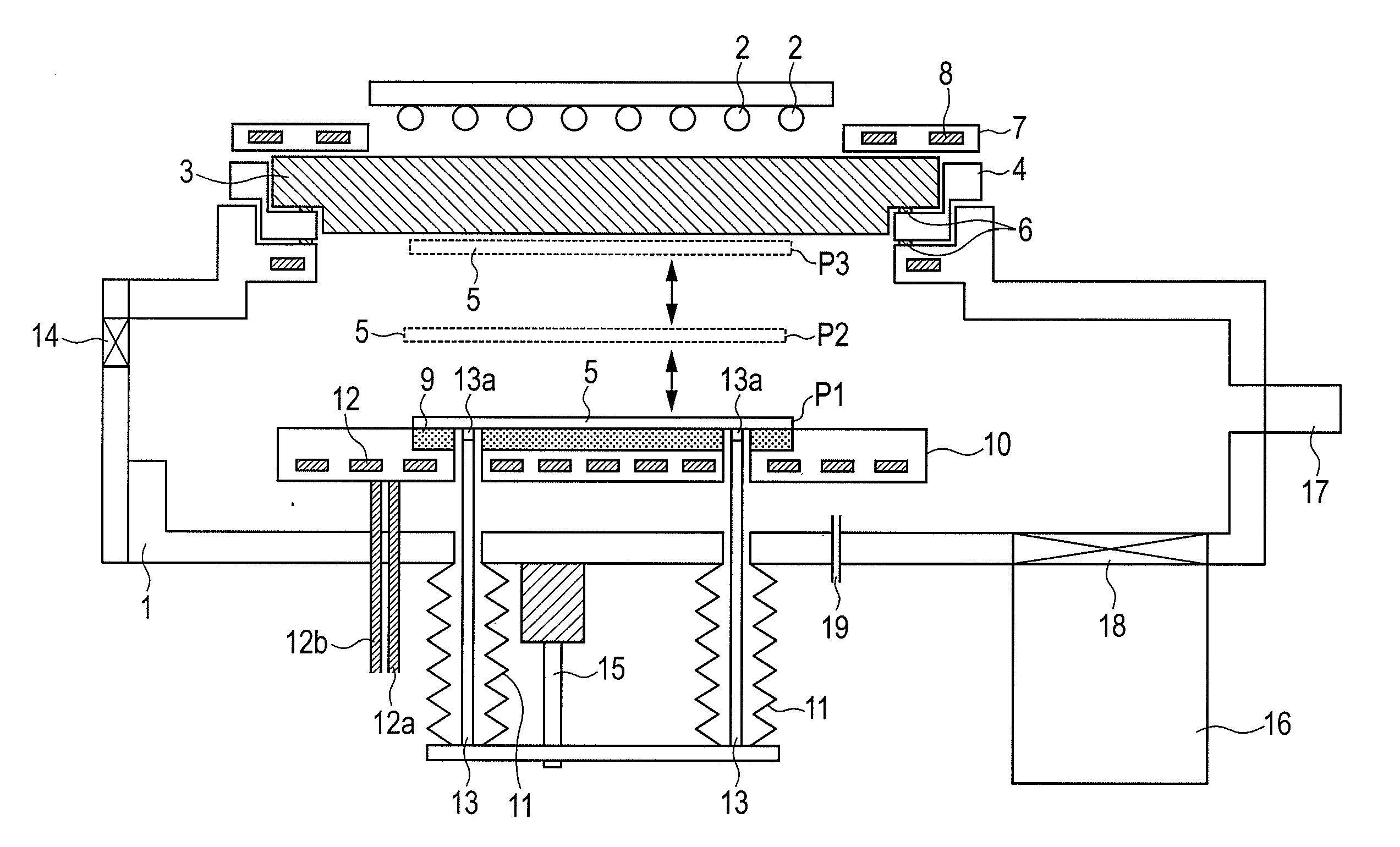Vacuum heating/cooling apparatus and manufacturing method of magnetoresistance element
a technology of magnetoresistance element and vacuum heating/cooling apparatus, which is applied in the direction of lighting and heating apparatus, drying machines, furnaces, etc., can solve the problems of large exposure time t, poor vacuum degree, and loss of transfer tim
- Summary
- Abstract
- Description
- Claims
- Application Information
AI Technical Summary
Benefits of technology
Problems solved by technology
Method used
Image
Examples
first embodiment
[0060]FIG. 1 is an apparatus configuration diagram of a vacuum heating / cooling apparatus according to this embodiment.
[0061]In FIG. 1, on an upper part of a vacuum chamber 1, a quartz window 3 which transmits heating light from a halogen lamp 2 is fixed through a vacuum seal member (not shown). This quartz window 3 functions as an incident portion for causing the heating light output from the halogen lamp 2 to enter the vacuum chamber 1. The vacuum seal member preferably has high heat resistance such as Viton (registered trademark) or Kalrez (registered trademark). By providing a ring 4 for attaching / detaching the quartz window between the vacuum chamber 1 and the quartz window 3 as illustrated in FIG. 1, attachment / detachment of the quartz window 3 is facilitated. The size of the quartz window 3 is preferably 1.5 times or more the size of a substrate 5. Also, the halogen lamp 2 as a radiation energy source which radiates the heating light is arranged on the atmosphere side. That is...
second embodiment
[0097]In the first embodiment, if the heating temperature is high or depending on the type of the substrate 5, when the substrate 5 is placed on the cooled substrate supporting base 9, the substrate might be split by thermal shock. In order to prevent such split of the substrate, in this embodiment, after the heating in the first embodiment is finished, the substrate 5 is not immediately placed on the substrate supporting base 9 when the lift pins 13 are lowered but the substrate is stopped once at a predetermined position above the substrate supporting base 9. Such a predetermined position is preferably within 20 mm above the substrate supporting base 9. Alternatively, during non-heating, the substrate 5 may be stopped once at a position where the distance between the halogen lamp 2 and the substrate 5 is 100 mm or more.
[0098]By configuring above, the substrate can be cooled while split is avoided. That is, in this embodiment, if the temperature of the substrate 5 has fallen to a t...
third embodiment
[0099]In the first and second embodiments, in order to further reduce time till the substrate temperature reaches the room temperature after the substrate 5 is placed on the cooled substrate supporting base 9, at least one of provision of an electrostatic adsorption mechanism such as an electrostatic chuck on the substrate supporting base 9 and supply of cooling gas to the surface of the substrate supporting base 9 is effective.
[0100]FIG. 4 is a diagram for explaining a mode in which an electrostatic chuck function is provided in the substrate supporting base of the vacuum heating / cooling apparatus illustrated in FIG. 1.
[0101]In FIG. 4, a substrate supporting base 41 is one adding the electrostatic chuck function to the substrate supporting base 9 illustrated in FIG. 1 according to this embodiment. Specifically, the substrate supporting base 41 made of a dielectric body is in contact with or incorporates wiring (not shown) which introduces electricity (electric power), and the wirin...
PUM
 Login to View More
Login to View More Abstract
Description
Claims
Application Information
 Login to View More
Login to View More - R&D
- Intellectual Property
- Life Sciences
- Materials
- Tech Scout
- Unparalleled Data Quality
- Higher Quality Content
- 60% Fewer Hallucinations
Browse by: Latest US Patents, China's latest patents, Technical Efficacy Thesaurus, Application Domain, Technology Topic, Popular Technical Reports.
© 2025 PatSnap. All rights reserved.Legal|Privacy policy|Modern Slavery Act Transparency Statement|Sitemap|About US| Contact US: help@patsnap.com



